-
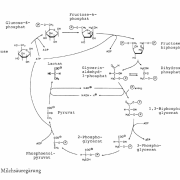 Elemente der Naturwissenschaft2002,2002Abbau und Umwandlung bei biochemischen Prozessen am Beispiel der Gärungen Hans-Joachim Strüh und Birgit Jäckel Summary We know from the history of arts and crafts that early experience of ‘practical chemistry’ dates back to very early times. Apart from the production of materials such as metal, glass and clay as well as tanning and dyeing... read more
Elemente der Naturwissenschaft2002,2002Abbau und Umwandlung bei biochemischen Prozessen am Beispiel der Gärungen Hans-Joachim Strüh und Birgit Jäckel Summary We know from the history of arts and crafts that early experience of ‘practical chemistry’ dates back to very early times. Apart from the production of materials such as metal, glass and clay as well as tanning and dyeing... read more -
 Elemente der Naturwissenschaft2002,2002Abbau der primären Silikate, Freisetzung der Nährstoffe und Tonmineralbildung Ihre Bedeutung für die Pflanzenernährung und eine nachhaltige Landwirtschaft Edwin Scheller Summary During normal soil development, nutrient-rich primary silicates and other minerals are broken down and the plant nutrients in them are released into the soil... read more
Elemente der Naturwissenschaft2002,2002Abbau der primären Silikate, Freisetzung der Nährstoffe und Tonmineralbildung Ihre Bedeutung für die Pflanzenernährung und eine nachhaltige Landwirtschaft Edwin Scheller Summary During normal soil development, nutrient-rich primary silicates and other minerals are broken down and the plant nutrients in them are released into the soil... read more -
Elemente der Naturwissenschaft2002,2002Metallprozesse Ein Thema der Lehrplanangaben Rudolf Steiners für den Chemieunterricht der 12. Klasse der Waldorfschule Günther Heuschkel Summary Rudolf Steiner proposed that in the twelfth school year at the Waldorf School chemistry should be taught in its most intimate connection with man. ‘It would be desirable to have an inorganic, an... read more
-
 Elemente der Naturwissenschaft2002,2002Erfahrungen und Vorschläge zum Chemieunterricht in der Waldorfschule Wolfgang Schad Summary How has education in chemistry developed during the 80 years of the Waldorf-School movement? The main points up to the present day are characterized, beginning with the approach of Eugen Kolisko. The obvious shortcoming is a special problem of... read more
Elemente der Naturwissenschaft2002,2002Erfahrungen und Vorschläge zum Chemieunterricht in der Waldorfschule Wolfgang Schad Summary How has education in chemistry developed during the 80 years of the Waldorf-School movement? The main points up to the present day are characterized, beginning with the approach of Eugen Kolisko. The obvious shortcoming is a special problem of... read more -
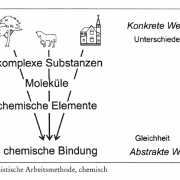 Elemente der Naturwissenschaft2002,2002Zu Reduktionismus und Phänomenologie im Unterricht Peter van den Breemer Summary This contribution deals with the connections to be found between reductionist and phenomenological chemistry. How can molecular thinking be linked with the manifest properties of substances and above all with the world of human perception? A ‘multi-level... read more
Elemente der Naturwissenschaft2002,2002Zu Reduktionismus und Phänomenologie im Unterricht Peter van den Breemer Summary This contribution deals with the connections to be found between reductionist and phenomenological chemistry. How can molecular thinking be linked with the manifest properties of substances and above all with the world of human perception? A ‘multi-level... read more -
Elemente der Naturwissenschaft2002,2002Die Bedeutung der Chemie für die Pädagogik und ihr sozialer Aspekt Ulrich Wunderlin Summary The significance of chemistry as a school subject with a structure for general education Will be outlined. In addition, the necessity of such an education will be explained. In accordance with the guidelines for education in Waldorf or Rudolf... read more
-
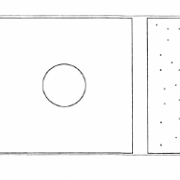 Elemente der Naturwissenschaft75,2001ELEMENTE DER NATURWISSENSCHAFT 75 2/2001 Der Begriff des Gegenraumes Oliver Conradt Summary The concept of counter space or negative space is developed from Goethe’s concept of space as described by the young Rudolf Steiner. Whilst the three dimensions of space are based on the relation between two separated objects, the three... read more
Elemente der Naturwissenschaft75,2001ELEMENTE DER NATURWISSENSCHAFT 75 2/2001 Der Begriff des Gegenraumes Oliver Conradt Summary The concept of counter space or negative space is developed from Goethe’s concept of space as described by the young Rudolf Steiner. Whilst the three dimensions of space are based on the relation between two separated objects, the three... read more -
 Elemente der Naturwissenschaft75,2001ELEMENTE DER NATURWISSENSCHAFT 75 2/2001 Doppeldrehung und Polarisation Johannes Grebe Gestalt wirkt auf Gestalt.I Rudolf Steiner Summary Based on a discovery of Haidinger, cyclic sequences of images as a result of an interplay of the optical elements analyser, transformer and polarizer are investigated. The change of the image... read more
Elemente der Naturwissenschaft75,2001ELEMENTE DER NATURWISSENSCHAFT 75 2/2001 Doppeldrehung und Polarisation Johannes Grebe Gestalt wirkt auf Gestalt.I Rudolf Steiner Summary Based on a discovery of Haidinger, cyclic sequences of images as a result of an interplay of the optical elements analyser, transformer and polarizer are investigated. The change of the image... read more -
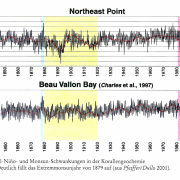 Elemente der Naturwissenschaft75,2001ELEMENTE DER NATURWISSENSCHAFT 75 2/2001 Der blaue Planet Erdgeschichtliche Betrachtungen über das Weltmeer Wolf-Christian Dullo Summary Understanding the Earth as a self-contained organism is fundamental to a Goethean approach. But how can we develop a concrete picture of it based on sensorial experience? An autonomous organism is... read more
Elemente der Naturwissenschaft75,2001ELEMENTE DER NATURWISSENSCHAFT 75 2/2001 Der blaue Planet Erdgeschichtliche Betrachtungen über das Weltmeer Wolf-Christian Dullo Summary Understanding the Earth as a self-contained organism is fundamental to a Goethean approach. But how can we develop a concrete picture of it based on sensorial experience? An autonomous organism is... read more -
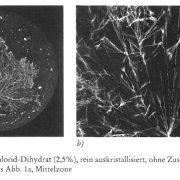 Elemente der Naturwissenschaft75,2001ELEMENTE DER NATURWISSENSCHAFT 75 2/2001 Einflüsse unterschiedlicher Behandlungen auf die biologische Wertigkeit von Kuhmilch Untersuchungen mit der Methode der Empfindlichen Kristallisation Haijo Knijpenga Summary The biological value of cow’s milk after pasteurisation and homogenisation was investigated by sensitive crystallisation.... read more
Elemente der Naturwissenschaft75,2001ELEMENTE DER NATURWISSENSCHAFT 75 2/2001 Einflüsse unterschiedlicher Behandlungen auf die biologische Wertigkeit von Kuhmilch Untersuchungen mit der Methode der Empfindlichen Kristallisation Haijo Knijpenga Summary The biological value of cow’s milk after pasteurisation and homogenisation was investigated by sensitive crystallisation.... read more